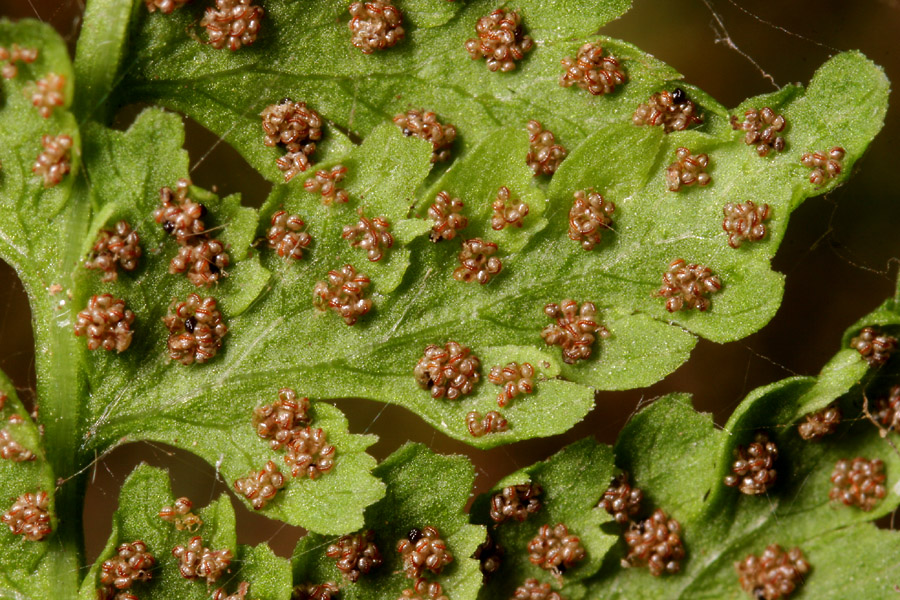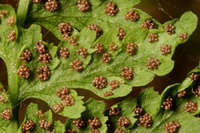Stems creeping, not cordlike, internodes short, beset with old petiole bases, hairs absent; scales tan to light brown, lanceolate, radial walls thin, luminae tan. Leaves monomorphic, clustered at stem apex, to 40 cm, nearly all bearing sori. Petiole dark at base, mostly green to straw-colored distally, shorter than or nearly equaling blade, base sparsely scaly. Blade lanceolate to narrowly elliptic, 1(--2)-pinnate-pinnatifid, widest at or just below middle, apex short-attenuate; rachis and costae lacking gland-tipped hairs or bulblets; axils of pinnae lacking multicellular, gland-tipped hairs. Pinnae typically at acute angle to rachis, often curving toward blade apex, margins crenulate; proximal pinnae pinnatifid to pinnate-pinnatifid, ± equilateral, basiscopic pinnules not enlarged; basal basiscopic pinnules sessile, base cuneate to obtuse, distal pinnae ovate to narrowly elliptic. Veins directed into teeth and notches. Indusia ovate to cup-shaped, without gland-tipped hairs. Spores spiny, usually 39--50 µm. 2 n = 168.
Sporulating summer--fall. Mostly on shaded rock and cliff faces but also occasionally on forest floors; 0--2800 m; N.B., N.S., Ont., Que.; Ark., Ariz., Conn., Del., Ill., Ind., Iowa, Kans., Ky., Maine, Md., Mass., Mich., Minn., Mo., Nebr., Nev., N.H., N.J., N.Y., N.C., Ohio, Okla., Pa., R.I., Tenn., Utah, Vt., Va., W.Va., Wis.
Long recognized as Cystopteris fragilis var. mackayi , C . tenuis was returned to species status by R. C. Moran (1983b). It is probably an allotetraploid originating from C . protrusa and an extinct diploid related to C . fragilis (C. H. Haufler 1985; C. H. Haufler and M. D. Windham 1991).
Cystopteris tenuis is common in eastern North America and less frequent at the northern and western perimeter of its range. In the center of its distribution (Minnesota, Iowa, Illinois, Wisconsin, Indiana, Ohio, Pennsylvania), the narrow, elliptic pinnae angled toward the blade apex and the rounded teeth make C . tenuis relatively distinct from C . fragilis and C . protrusa (although the early season, sterile leaves of C . protrusa often resemble those of C . tenuis ). In the west and especially in the northeast, C . tenuis and C . fragilis are difficult to distinguish. For the most part, C . fragilis is confined to higher latitudes and elevations than C . tenuis , but the two species can be sympatric and occasionally form sterile tetraploid hybrids. Cystopteris protrusa and C . tenuis are infrequently sympatric, but where they are, sterile triploid hybrids can occur. Hybrids between C . tenuis and C . tennesseensis are recognized as C . × wagneri (R. C. Moran 1983). Hybridization between C . tenuis and C . bulbifera has also been reported (R. C. Moran 1982b). This hybrid, C . × illinoensis R. C. Moran, is known only from the type and needs to be studied further.
Perennial fern 8 - 40 cm tall
Leaves: clustered, stalked, green, delicate, thin, deciduous (dying back in winter), 5 - 30 cm long, widest at or just below middle, in outline lance-shaped to narrowly elliptic with short pointed tip, but pinnately compound. The main "midrib" (rachis) never has gland-tipped hairs or bulblets.
Rhizome: creeping, short (2 - 4 cm), compact with short internodes, hairless, but with tan to light brown lance-shaped scales, and covered with numerous remnant leaf stalk bases.
Leaf stalks: clustered at tip of rhizome, dark at base, mostly green to straw-colored upward, shorter than or equaling leaf blade, and sparsely scaly at base.
Spores: 64 per sac, brownish, all of one kind, single-sectioned (monolete), usually 39 - 50 microns long, oblong or kidney-shaped, and spiny. Produced on nearly all the leaves, the spores give rise to the gametophyte (the sexual phase of the plant), which is small, green, heart-shaped, hairless or often with glands or hairs, and sits above the ground.
Similar species: Cystopteris tenuis is often confused with C. fragilis, but that species has its pinnae perpendicular to the rachis and the tips never point toward leaf apex, the upper pinnae are more widely triangular to widely egg-shaped, and the margins of the pinnae and their segments are sharply toothed. Also similar is C. protrusa, but its leaves are clustered 1 - 4 cm behind the tip of the rhizome, the rhizome and leaf stalk bases have obvious yellow to golden hairs, and the spores are usually much smaller (28 - 34 microns). The other two species of Cystopteris in the Chicago Region, C. bulbifera, C. tennesseensis, differ by having glandular hairs on parts of the leaves, the leaf blades are usually widest at or near the base, the tips taper to points, and the rachises and costae may have bulblets.
Habitat and ecology: Occasional in mesophytic woods and ravines.
Occurence in the Chicago region: native
Notes: This species has often been included within the species name C. fragilis, and more particularly as a variety of that species, C. fragilis var. mackayi. The species tends to be more common in eastern North America than in our region. It is probably an allotetraploid species believed to have originated from hybridization between C. protrusa and an unknown, and extinct, diploid species related to C. fragilis (Haufler et al. 1993).
Etymology: Cystopteris comes from the Greek words cystis, meaning bladder, and pteris, meaning fern. Tenuis means slender, or thin.
Author: The Field Museum
Lvs less cleft, the pinnules more remote, the lowermost pinnules only slightly lobed and mostly cuneate at the base; indusium ca 0.5 mm, or nearly obsolete, usually entire; a little more southern, from N.S. and N.B. and s. Que. to Minn. and Nebr., s. to Va., s. Ill., and Mo., and in the mts. to n. Ga. (C. tenuis)
Gleason, Henry A. & Cronquist, Arthur J. 1991. Manual of vascular plants of northeastern United States and adjacent Canada. lxxv + 910 pp.
©The New York Botanical Garden. All rights reserved. Used by permission.




